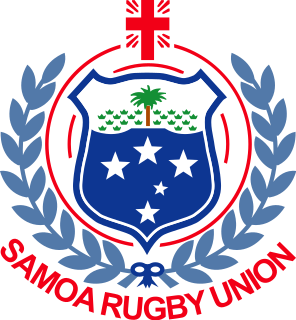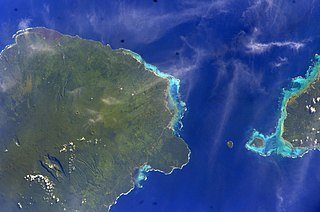
The country of Samoa consists of the two large islands of Upolu and Savai'i and eight smaller islands located about halfway between Hawaii and New Zealand in the Polynesian region of the South Pacific Ocean. The island of Upolu is home to nearly three-quarters of Samoa's population and its capital city of Apia. Samoa occupies an almost central position within Polynesia. The climate is tropical, with a rainy season from November to April. To the east is the smaller American Samoa.
Samoan mythology tells stories of many different deities. There were deities of the forest, the seas, rain, harvest, villages, and war. There were two types of deities, atua, who had non-human origins, and aitu, who were of human origin.
Fiji Airways, is the flag carrier airline of Fiji and operates international services from its hubs in Fiji to 13 countries and 23 cities including Australia, New Zealand, Samoa, Tonga, Tuvalu, Kiribati, Vanuatu and Solomon Islands (Oceania), the United States, Hong Kong and Singapore. It has an extended network of 108 international destinations through its codeshare partners. The airline resumed direct flights to Narita, Tokyo on 3 July 2018. The Fiji Airways Group brings in 64 percent of all visitors who fly to Fiji, employs over 1000 employees, and earns revenues of over FJD$815 million.
A footprint is an impression left by a foot or shoe.

The Samoa national rugby union team is governed by the Samoa Rugby Union. The name Manu Samoa is in honour of a famous Samoan warrior. They perform a traditional Samoan challenge called the siva tau before each game. Samoa Rugby Union were formerly members of the Pacific Islands Rugby Alliance (PIRA) along with Fiji and Tonga. They are ranked 16th in the world.

Falealupo is a village in Samoa situated at the west end of Savai'i island 20 miles (32 km) from the International Date Line used until December 29, 2011. The village has two main settlements, Falealupo-Uta, situated inland by the main island highway and Falealupo-Tai, situated by the sea. The road to the coastal settlement is about 9 km, most of it unsealed, from the main highway.

The Fiji national rugby union team competes every four years at the Rugby World Cup, and their best performances were the 1987 and 2007 tournaments when they defeated Argentina and Wales respectively to reach the quarterfinals. Fiji also regularly plays test matches during the June and November test windows. Fiji also plays in the Pacific Tri-Nations, and has won the most Pacific Tri-Nations Championships of the three participating teams.

Aiga-i-le-Tai is a district of Samoa which includes the small islands of Manono, Apolima and tiny uninhabited Nu'ulopa lying in the Apolima Strait between the country's two main islands of Upolu and Savai'i.

Fa'asaleleaga is a district of Samoa situated on the eastern side of Savai'i island. It has a population of 12,949.

The Roman Catholic Archdiocese of Samoa–Apia consists of the Independent State of Samoa.

SKY Pacific is a Fiji based pay TV service formerly owned by Fiji Television Limited delivering encrypted signals of 25 channels via direct-to-home (DTH) satellite on C-band to subscribers in Fiji and across the South Pacific. It is headquartered in the capital city of Fiji, Suva City with branch offices in Suva, Lautoka, Nadi and Labasa. On April 1, 2016, Digicel Fiji officially acquired the company.

Footprints are the impressions or images left behind by a person walking or running. Hoofprints and pawprints are those left by animals with hooves or paws rather than feet, while "shoeprints" is the specific term for prints made by shoes. They may either be indentations in the ground or something placed onto the surface that was stuck to the bottom of the foot. A "trackway" is set of footprints in soft earth left by a life-form; animal tracks are the footprints, hoofprints, or pawprints of an animal.
Fitiuta, also known as Fiti'uta or Maia, is a village on the northeast coast of Ta‘ū island, one of the Manu‘a Islands in American Samoa. According to the US Census of 2000, Fitiuta had a population of 358, down from 454 in 1990. As of the 2010 United States Census, it had a population of 270. The village of Fitiuta is made up of two hamlets: Maia and Leusoali'i, the latter of which is the most eastern area on the island. Historically, they were classified as villages. The town has two shops, a hotel and a church, which was recently built. Fitiuta Airport is located in the town.

Faleolo International Airport is an airport located 40 kilometres (25 mi) west of Apia, the capital of Samoa. Until 1984, Faleolo could not accommodate jets larger than a Boeing 737. Services to the United States, Australia, or New Zealand, could only land at Pago Pago International Airport in American Samoa. Since the airport's expansion most international traffic now uses Faleolo.
Alfred Beranaliva Uluinayau is a New Zealand rugby union player currently coaching professionally in Japan. He has represented Fiji as a fullback and is also a former Auckland player and All Black trialist.

Safotulafai is a traditional village at the east end of Savai'i island with historical and political significance in Samoa's history. It is the traditional center of the island of Savaii, now became the center of Fa'asaleleaga political district.
Nu'ulopa is a small uninhabited island in the Apolima Strait between the islands of Upolu and Savai'i in Samoa. The island is part of Aiga-i-le-Tai district.
Nu'u is a village on the island of Savai'i in Samoa. It is situated on the south coast of the island in Palauli district.
The Pacific Rugby League International is a rugby league test match that has been played between two Pacific Island nations during the National Rugby League's annual representative weekend since 2013. The fixture was held at Penrith Stadium for the 2013 and 2014 test matches. In 2015, two fixtures were held; Samoa and Tonga competed for the Polynesian Cup while Fiji and Papua New Guinea competed for the Melanesian Cup at Cbus Super Stadium. In 2016 the fixtures returned to New South Wales and were held at Parramatta's Pirtek Stadium.

Severe Tropical Cyclone Gita was the most intense tropical cyclone to impact Tonga since reliable records began. The second named storm and first major tropical cyclone of the 2017–18 South Pacific cyclone season, Gita originated from a monsoon trough that was active in the South Pacific in early February 2018. First classified as a tropical disturbance on 3 February, the nascent system meandered near Vanuatu for several days with little development. After acquiring a steady east trajectory near Fiji, it organized into a Category 1 tropical cyclone on 9 February near Samoa. Arcing south in a clockwise turn, the system rapidly intensified, and became a severe tropical cyclone on 10 February near Niue.















